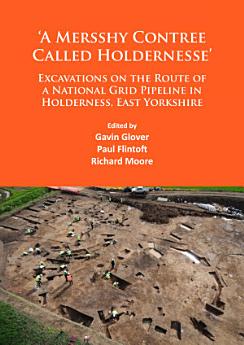‘A Mersshy Contree Called Holdernesse’: Excavations on the Route of a National Grid Pipeline in Holderness, East Yorkshire: Rural Life in the Claylands to the East of the Yorkshire Wolds, from the Mesolithic to the Iron Age and Roman Periods, and beyond
Gavin Glover · Paul Flintoft · Richard Moore
Mar 2016 · Archaeopress Publishing Ltd
Ebook
298
Pages
family_home
Eligible
info
reportRatings and reviews aren’t verified Learn More
About this ebook
Twenty sites were excavated on the route of a National Grid pipeline across Holderness, East Yorkshire. These included an early Mesolithic flint-working area, near Sproatley. In situ deposits of this age are rare, and the site is a significant addition to understanding of the post-glacial development of the wider region. Later phases of this site included possible Bronze Age round barrows and an Iron Age square barrow. Elsewhere on the pipeline route, diagnostic Mesolithic, Neolithic and Bronze Age flints, as well as Bronze Age pottery, provide evidence of activity in these periods. Iron Age remains were found at all of the excavation sites, fourteen of which had ring gullies, interpreted as evidence for roundhouse structures. The frequency with which these settlements occurred is an indication of the density of population in the later Iron Age and the large assemblage of hand-made pottery provides a rich resource for future study. Activity at several of these sites persisted at least into the second or early third centuries AD, while the largest excavation site, at Burton Constable, was re-occupied in the later third century. However, the pottery from the ring gullies was all hand-made, suggesting that roundhouses had ceased to be used by the later first century AD, when the earliest wheel-thrown wares appear. This has implications for understanding of the Iron Age to Roman transition in the region. Late first- or early second-century artefacts from a site at Scorborough Hill, near Weeton, are of particular interest, their nature strongly suggesting an association with the Roman military. With contributions by: Hugo Anderson-Whymark (flint), Kevin Leahy (metal, glass, worked bone), Terry Manby (earlier prehistoric pottery), Chris Cumberpatch (hand-made pottery), Rob Ixer (petrography), Derek Pitman and Roger Doonan (suface residues: ceramics and slag), Ruth Leary (Roman pottery), Felicity Wild (samian ware), Kay Hartley (mortaria), Jane Young with Peter Didsbury (post-Roman pottery), Ruth Shaffrey (worked stone), Lisa Wastling (fired clay), Jennifer Jones (surface residues: fired clay), Katie Keefe and Malin Holst (human bone), Jennifer Wood (animal bone), Don O’Meara (plant macrofossils), Tudur Burke Davies (pollen) and Matt Law (molluscs). Illustrations by: Jacqueline Churchill, Dave Watt and Susan Freebrey
Rate this ebook
Tell us what you think.
Reading information
Smartphones and tablets
Install the Google Play Books app for Android and iPad/iPhone. It syncs automatically with your account and allows you to read online or offline wherever you are.
Laptops and computers
You can listen to audiobooks purchased on Google Play using your computer's web browser.
eReaders and other devices
To read on e-ink devices like Kobo eReaders, you'll need to download a file and transfer it to your device. Follow the detailed Help Center instructions to transfer the files to supported eReaders.








